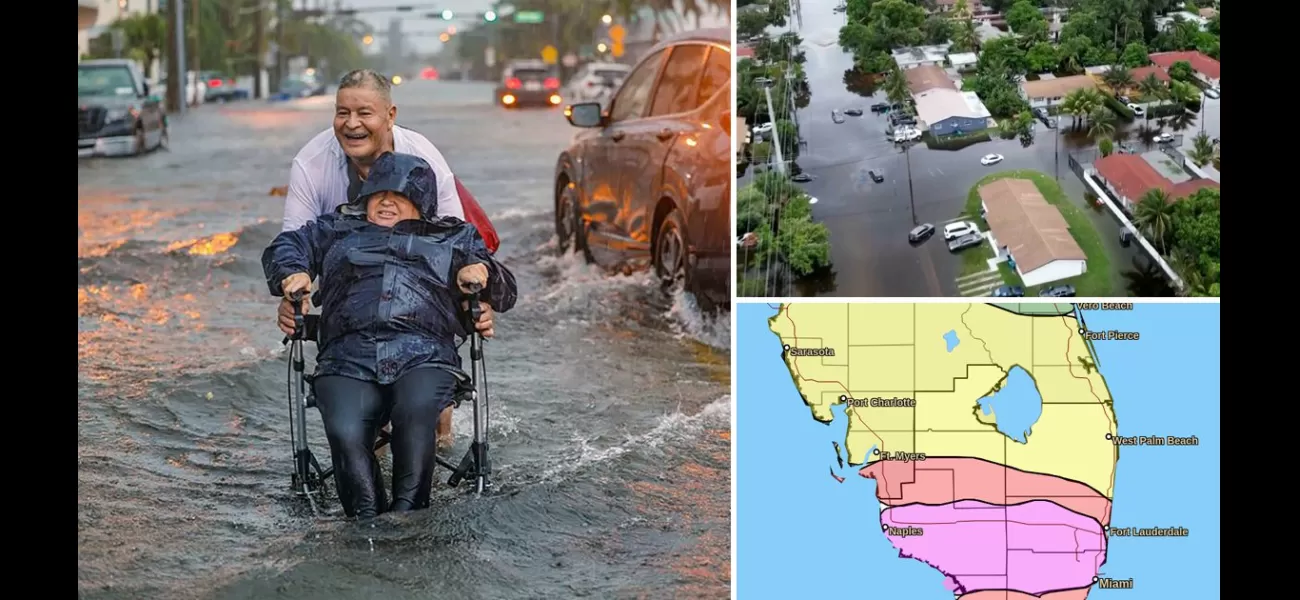A map displays flood zones in South Florida due to heavy rain from a tropical storm.
Tropical disturbance causes flooding in South Florida, marking the start of hurricane season in the Atlantic.
June 13th 2024.

On Thursday, the residents of South Florida were faced with a flash flood risk as a disorganized storm system swept through the region. This was the first tropical disturbance of the hurricane season, and it caused chaos by flooding streets and creating rivers where there were once roads. The storm system, which originated in the Gulf of Mexico, brought rare flash floods to cities like Miami and Fort Lauderdale, leaving many drivers stranded and forcing the cancellation of flights.
One driver, Gladys Adriancen, shared her experience with NBC Miami, saying, "I got stuck with this car, if that car would move I would move too. I feel so bad, so terrible, this has never happened to me in my life." The situation was dire as the National Weather Service issued a warning for possible flash flooding across South Florida on Thursday.
Aerial images showed the aftermath of the storm, with multiple cars stranded on roads in Northeast Miami-Dade County. Even the Fort Lauderdale-Hollywood International Airport was drenched in over a foot of rain. And the threat was not over yet, as the NWS warned of additional heavy rainfall and the possibility of more flash flooding.
The NWS Miami-South Florida shared on social media that, "An additional round of heavy rainfall is forecast across SFL today as a large convective band of showers & thunderstorms develops & move southward for the 3rd day in a row. Even a small duration of heavy rainfall could lead to more flash flooding!" This was a cause for concern as the storm system continued to linger over South Florida.
The NWS also shared radar images and an excessive rainfall outlook map, which showed high risk areas including Miami, Fort Lauderdale, and Naples, with slight risk areas in other parts of the state. And as the day progressed, the risk of excessive rainfall and rapid flooding remained, with the NWS updating their map and issuing warnings for certain areas.
They wrote, "A *HIGH* Risk of Excessive Rainfall has been issued for the I-75 Corridor. This means that widespread flash flooding is expected. Locally catastrophic flash flooding is possible." The severity of the situation was evident as Governor Ron DeSantis declared a state of emergency for several counties. In Collier County alone, over 25 inches of rain had already fallen.
The storm also brought an EF-1 tornado to Hobe Sound, causing destruction in its path. The tropical disturbance may not have reached hurricane status, but it was still causing havoc in its wake. And according to the NWS, this was just the beginning of what is forecasted to be an extremely active hurricane season.
"Regardless of development," they told the Daily Mail, "Heavy rainfall is forecast to continue across portions of the Florida peninsula during the next few days." The people of South Florida were urged to stay vigilant and take precautions as the storm system continued to wreak havoc.
One driver, Gladys Adriancen, shared her experience with NBC Miami, saying, "I got stuck with this car, if that car would move I would move too. I feel so bad, so terrible, this has never happened to me in my life." The situation was dire as the National Weather Service issued a warning for possible flash flooding across South Florida on Thursday.
Aerial images showed the aftermath of the storm, with multiple cars stranded on roads in Northeast Miami-Dade County. Even the Fort Lauderdale-Hollywood International Airport was drenched in over a foot of rain. And the threat was not over yet, as the NWS warned of additional heavy rainfall and the possibility of more flash flooding.
The NWS Miami-South Florida shared on social media that, "An additional round of heavy rainfall is forecast across SFL today as a large convective band of showers & thunderstorms develops & move southward for the 3rd day in a row. Even a small duration of heavy rainfall could lead to more flash flooding!" This was a cause for concern as the storm system continued to linger over South Florida.
The NWS also shared radar images and an excessive rainfall outlook map, which showed high risk areas including Miami, Fort Lauderdale, and Naples, with slight risk areas in other parts of the state. And as the day progressed, the risk of excessive rainfall and rapid flooding remained, with the NWS updating their map and issuing warnings for certain areas.
They wrote, "A *HIGH* Risk of Excessive Rainfall has been issued for the I-75 Corridor. This means that widespread flash flooding is expected. Locally catastrophic flash flooding is possible." The severity of the situation was evident as Governor Ron DeSantis declared a state of emergency for several counties. In Collier County alone, over 25 inches of rain had already fallen.
The storm also brought an EF-1 tornado to Hobe Sound, causing destruction in its path. The tropical disturbance may not have reached hurricane status, but it was still causing havoc in its wake. And according to the NWS, this was just the beginning of what is forecasted to be an extremely active hurricane season.
"Regardless of development," they told the Daily Mail, "Heavy rainfall is forecast to continue across portions of the Florida peninsula during the next few days." The people of South Florida were urged to stay vigilant and take precautions as the storm system continued to wreak havoc.
[This article has been trending online recently and has been generated with AI. Your feed is customized.]
[Generative AI is experimental.]
0
0
Submit Comment





